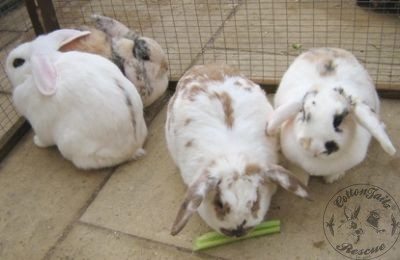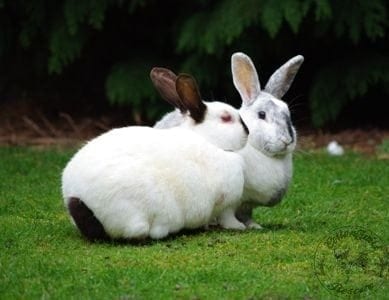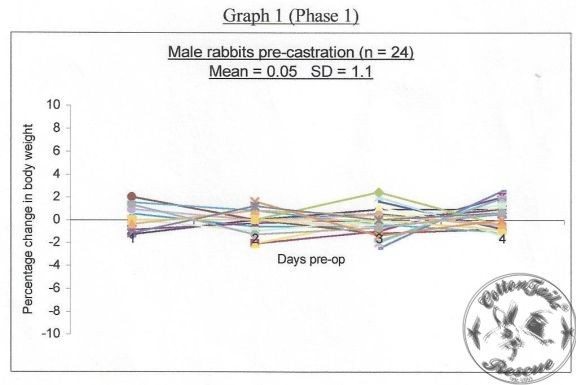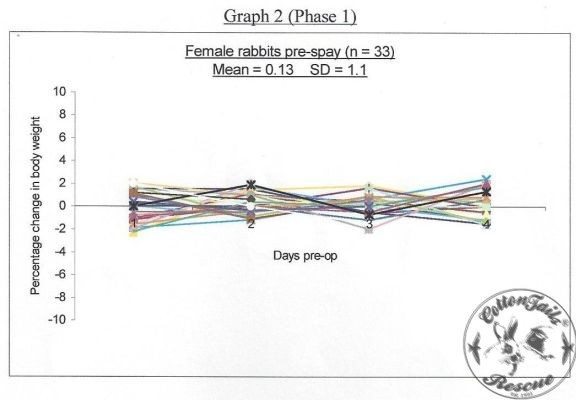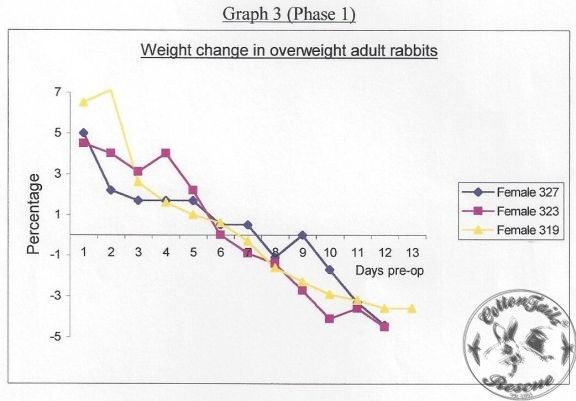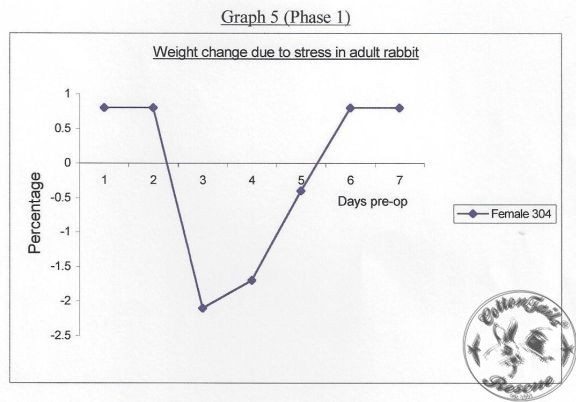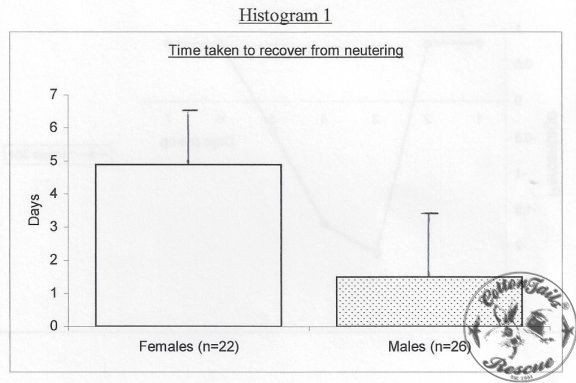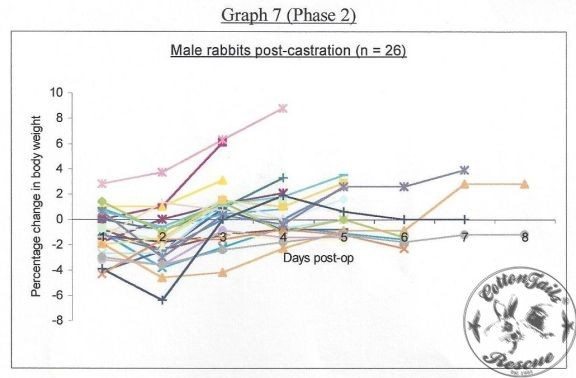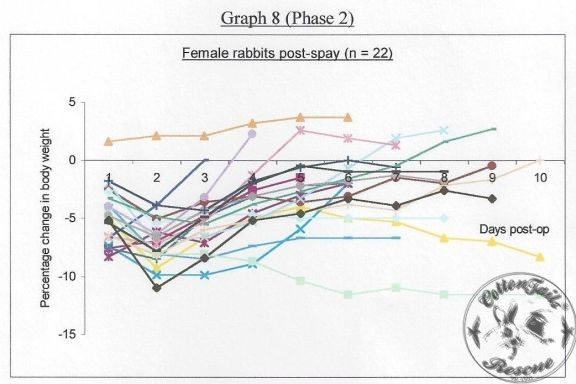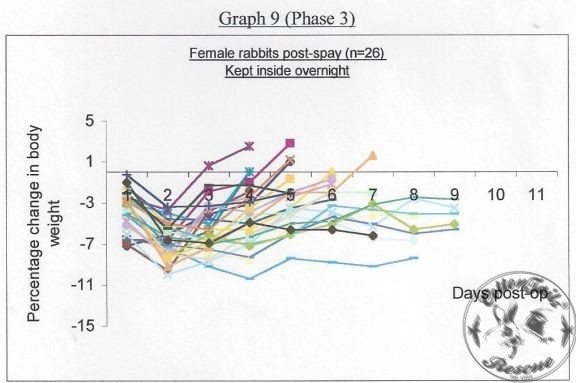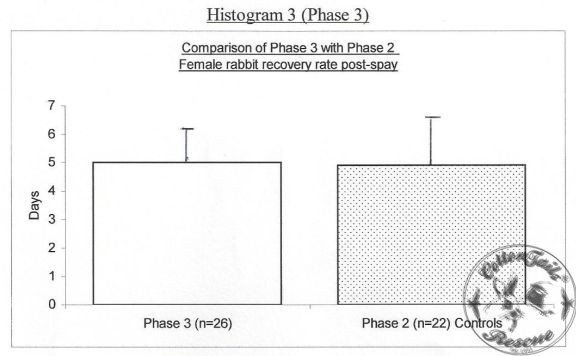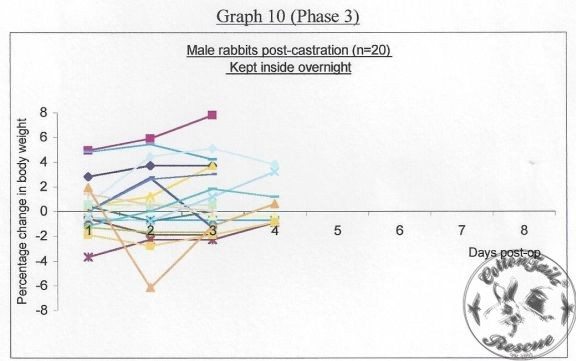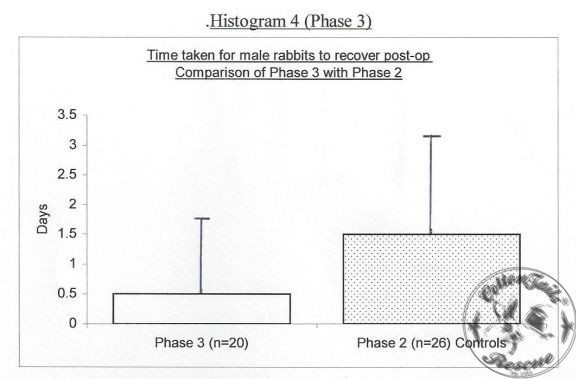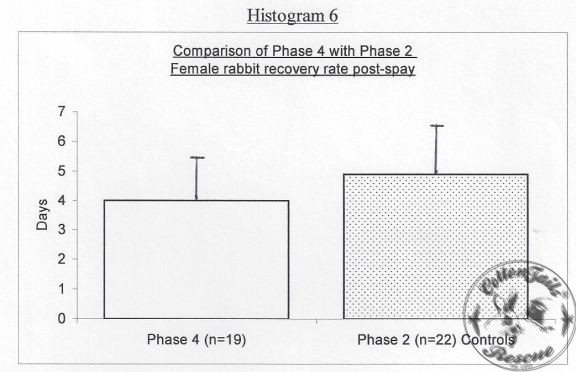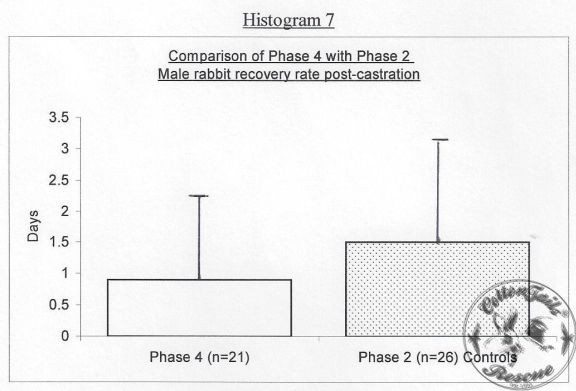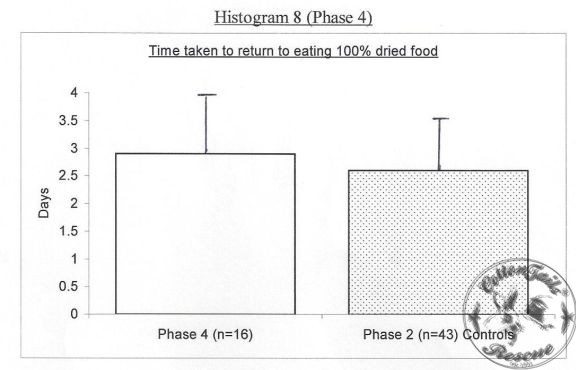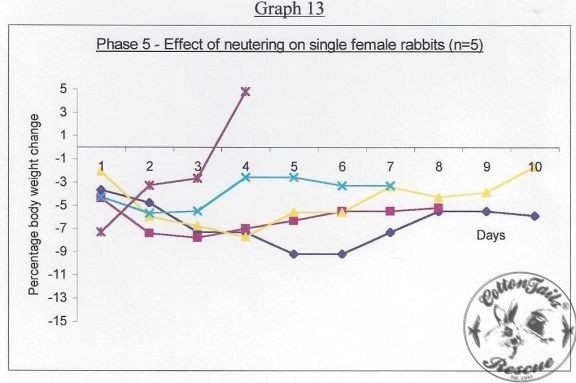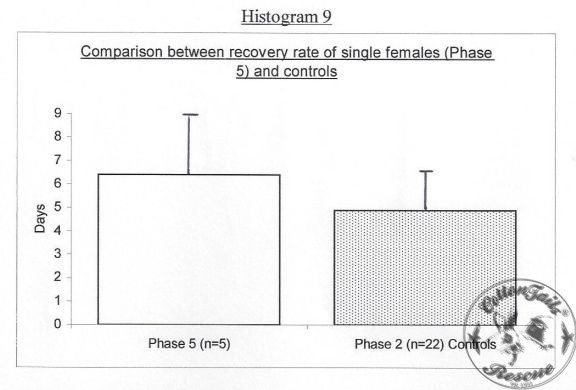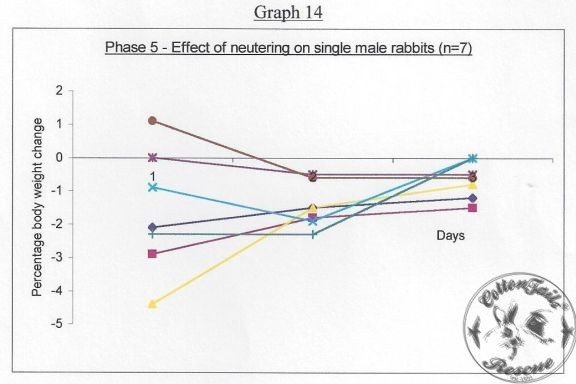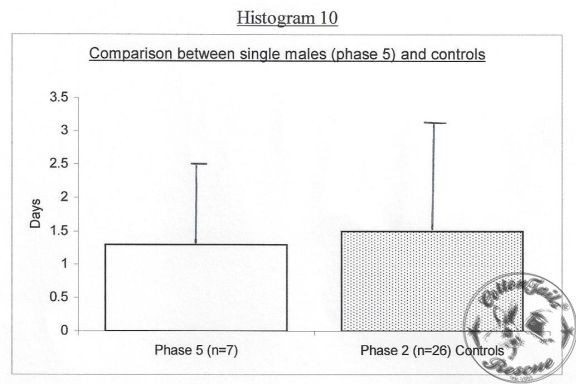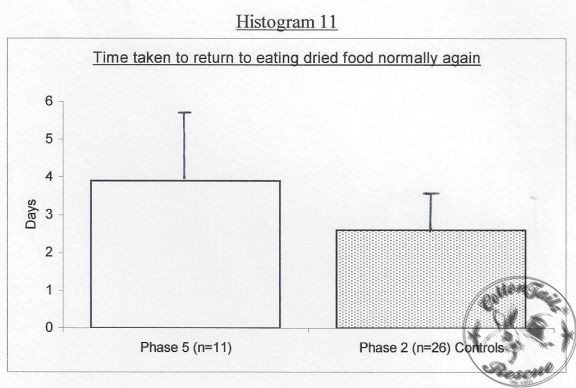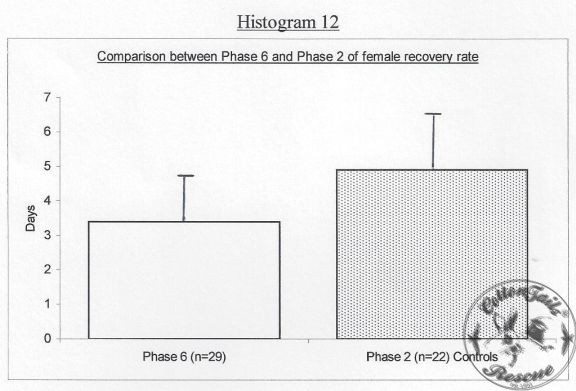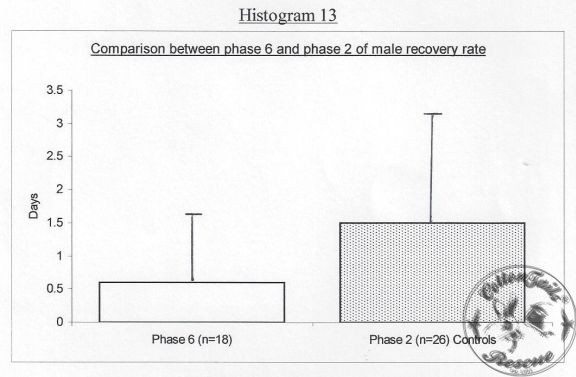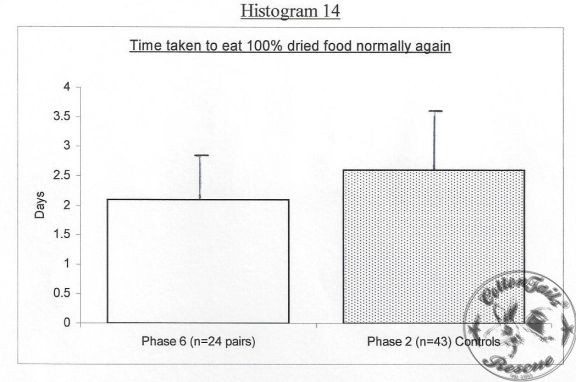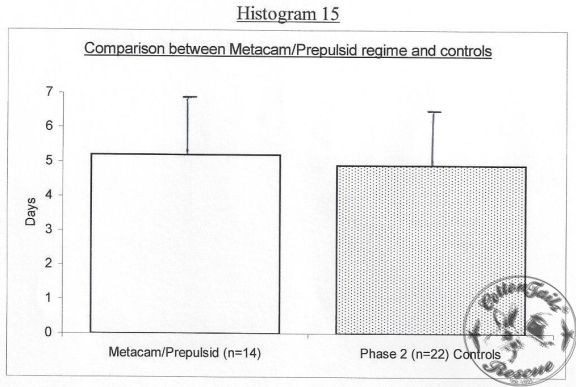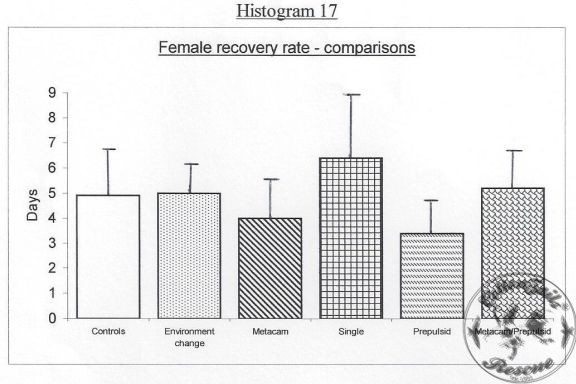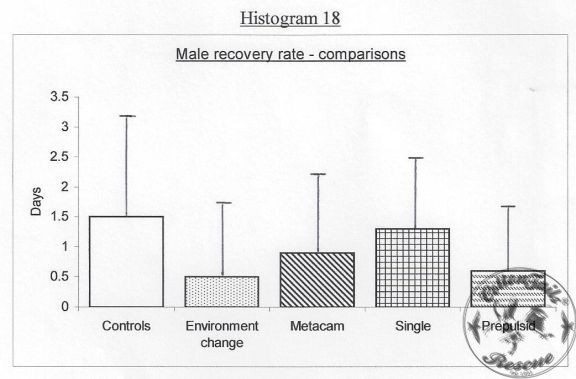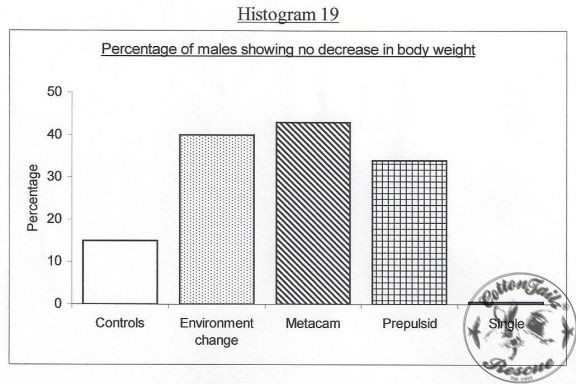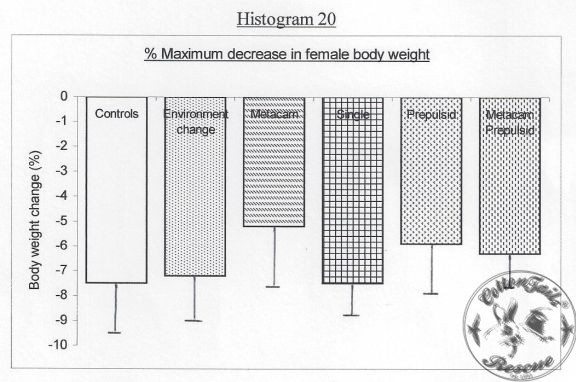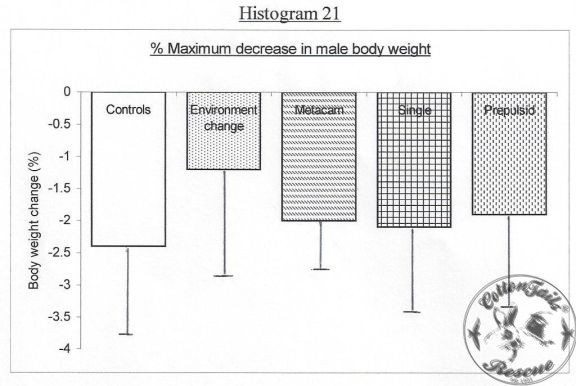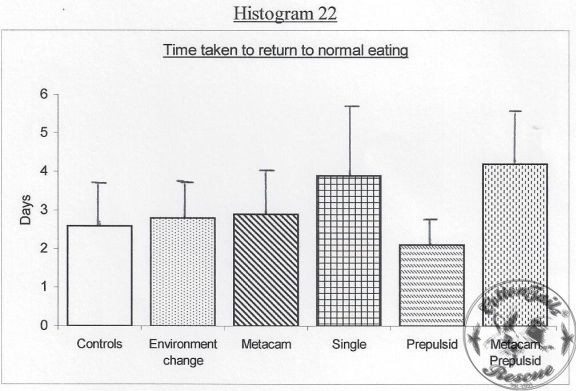This article includes some tips about helping your rabbit through the neutering procedure. Also, it presents the conclusions of the CottonTails neutering study based on 264 rabbits monitored before and after their neutering operations to determine what measures could be taken to help alleviate adverse effects such as pain and stress to enable them to recover as quickly as possible.
Since the study was undertaken, there have been some advances in medications, which are considered at the end of the study. To find the conclusions, scroll down towards the end. For a “behind the scenes” look at what happens before a neutering run to the vets, go to the end of the article and click on the film.
Introduction
Deciding to neuter your rabbit can be a very daunting prospect. Ultimately, however, it will be one of the best decisions you can make for your pet’s future health. Not only will neutering prevent unwanted litters, but it also reduces aggression and territorial behaviour, stops urine spraying, and prevents uterine cancer – a significant killer of female rabbits. To ensure long-term compatibility, neutering rabbits is essential if you intend to keep them in pairs or groups.
With pet rabbits in general, it is still the minority that is neutered compared to the majority that is not, and this can mainly be blamed on the high costs involved, as well as owner apathy. However, some reluctance can also be blamed on owner ignorance regarding perceived suffering and risks. This is despite modern veterinary techniques and knowledge, where neutering rabbits of both sexes is now considered a routine operation.
Minimising Risks
Any small risks associated with neutering can be minimised in several ways. The rabbit must be in good, healthy condition to undergo any anaesthetic procedure and should be fed as usual right up until the operation to prevent digestive problems. Ensure that the vet carrying out the procedure is experienced and has a good success rate with both sexes.
Ensure pain relief is given post-operatively and that heat pads are used. Skin adhesive should be used instead of external stitches to prevent the rabbit from re-opening the incision (especially important in females). Suppose the rabbit is still showing signs of being affected by the anaesthetic once at home. In that case, it is advisable to keep them inside overnight to prevent chilling. Otherwise, returning the rabbit to their normal environment as soon as possible is beneficial to reduce stress.
Small treats such as pieces of celery and other vegetables will help prevent gut stasis (constipation), a severe condition in rabbits that often has fatal results. This is especially important in females as they often refuse to eat dried food for a couple of days post-spay but will readily nibble hay or fresh goodies. Whilst it is normal for a female to refuse to eat on the day she returns home, she should start to nibble on things like grass, dandelion leaves, and some green vegetables at some point during the next day.
The vet should provide you with pain relief medication to give her for 2-3 days post-spay, which helps encourage females to eat again. She should also pass some droppings at some point during the day after her operation. Failure to eat anything within 24-36 hours and not pass any droppings may indicate the onset of gut stasis, in which case the vet must be notified immediately. However, the stress of taking her to the vet again will not help, so be sure she needs to go (not eating or passing any droppings within 24-48 hours post-operation).
The Study – summary
Both male and female rabbits are neutered as a routine before re-homing here at CottonTails®, so the experience of putting hundreds of rabbits a year “through the system” has taught me a great deal about what factors are essential in the recovery of a newly castrated or spayed rabbit once they have returned home.
Using body weight changes and the time taken to return to normal eating again as factors in determining post-operative recovery, I undertook a study of 264 rabbits to discover the effects of painkillers, gut stimulants, change of environment, and companionship upon recovery time. It became clear that factors such as being overweight, underweight, selective feeders (picking out selected bits from dried food and leaving the rest), personality type, in a compatible paired relationship or single, actively growing, ill-health or old can all influence the length of time taken to recover from the neutering operation.
Male rabbits recovered on average in less than two days. A quarter of the males studied showed a small beneficial effect of being kept indoors overnight for the first night post-castration, and a similar number also benefited from pain relief or administration of a gut stimulant. Interestingly, giving both pain relief and a gut stimulant together appeared not to be so effective in males and females as providing one or the other, but further study would be needed to find out why. Whether the males were single or in compatible pairs appeared to make little difference, as recovery was rapid anyway.
Female rabbits took, on average, just under five days to recover. It must be remembered, however, that whilst the post-neutering recovery rate for both sexes is relatively rapid, the female operation is a significant procedure, and care must be taken not to incur any internal damage by rough handling or strenuous exercise for some time afterwards. Keeping female rabbits inside overnight appeared to have no beneficial effect. However, it must be taken into consideration possible chilling if the rabbit is still under the effects of the anaesthetic before placing back outside (assuming that the rabbit is not a house rabbit anyway). Pain relief or gut stimulant administration appeared to speed up recovery, and females in compatible bonded pairs recovered quicker than those kept on their own. This may reflect their need for support and stimulation during this stressful time.
The results of this study should reassure owners of rabbits about to be neutered that the large majority of rabbits recover quickly from their operations, and the many benefits far outweigh any short-term discomfort. Asking your vet to provide pain relief such as Metacam and/or a gut stimulant such as Prepulsid or Metaclopromide for the first 48 hours post-operation is a good idea. It is also essential for rabbits, usually kept in compatible bonded pairs, to be reunited at the first possible opportunity, usually upon their return home, as this will aid recovery, especially in females. In most cases, it is best to take the partner when you collect their partner from the vets so they can travel back home together.
Neutering Study – introduction
Having your rabbit neutered is one of the most difficult but ultimately one of the best decisions a rabbit owner can make. However, this can be fraught with worries and insecurities, especially if one has “lost” a much-loved pet previously whilst under an anaesthetic.
At CottonTails® rabbit and guinea pig rescue, all our male and female rabbits were neutered before being re-homed in compatible pairs, so I have accumulated a wealth of experience and information that has been very useful.
Only when you inquire about neutering do you realise how much variation there is between operation technique, care pre and post-op, and the advice given to owners when taking bunnies home. This study has been carried out to determine what factors are essential in the recovery of a newly neutered rabbit once they have been brought home.
Not all vets use the same anaesthetic procedures, so although our rabbits and guinea pigs return to us in the late afternoon fully alert, some pet rabbits may be returned to the owners’ care whilst still under anaesthetic effects, leaving them vulnerable to chilling. This factor must be taken into account. However, it is still my view, backed by the experience of having had several hundred rabbits neutered yearly, that once they are alert and mobile, the advantages of returning to their usual surroundings outweigh other concerns regarding a quick and effective return to normal.
Furthermore, I have noticed that rabbits that live with another rabbit in a “bonded” relationship recover quicker, i.e., eat, drink, and move about sooner than rabbits that live on their own. This is especially apparent with females, as I have observed that most male rabbits appear to recover relatively quickly anyway, their operation being much less “invasive”. In this study, body weight has been used to indicate recovery rate.
With these points in mind, the study was divided into six phases:
- Background (control) data – to establish what “normal” change in body weight, if any, occurs with rabbits on a day-to-day basis.
- To compare the change of weight after neutering with pre-op control values, the rabbits are returned immediately post-op to their usual territory/environment with their partner or group. Also, to compare the recovery rate of female rabbits under six months of age with those over six months (fully grown).
- To establish the effect of unfamiliar surroundings upon neutering recovery rates, i.e. instead of returning to their usual environment, the rabbits were kept inside overnight post-op. but still being kept in their usual pairs/groups.
- To compare the neutering recovery rates between rabbits returned to their usual environment (phase 2) and those with the addition of daily administration of painkiller Metacam for three days post-op. The rabbits were kept in their usual pairs/groups.
- To establish the effect of neutering on rabbits housed singly compared with the recovery rates of rabbits kept in compatible pairs/groups (phase 2).
- To compare the neutering recovery rates between rabbits returned to their usual environment (phase 2) and those with the addition of twice daily administration of Prepulsid for two days post-op.
Method
1. Background data. The rabbits were kept in 6’ x 2’ x 2’ hutches, most with attached exercise pens (6’ x 3’ x 4’), access being allowed 24 hours a day. All rabbits were health-checked and VHD vaccinated upon arrival. Compatible paired rabbits (female/female, male/female, male/male) or rabbits in compatible groups were weighed approximately the same time every morning before feeding before their neutering operation. Rabbits were usually neutered within two weeks of their arrival at the rescue centre. It should be noted that male/male pairings are generally only successful if the rabbits are brought up together and are still getting on well before their neutering operation. This is best carried out as soon as their testes descend between 3 – 4 months of age.
A method of interpreting body weight had to be found to take into account the following factors that could cause misleading results:
(a) Rabbits arriving at the centre very overweight. Such rabbits are put on a strictly controlled diet so that weight loss would be expected anyway.
(b) Underweight rabbits. Rabbits that arrived undernourished would be expected to gain weight steadily when given the correct diet.
(c) Rabbits less than six months. Baby and young adult rabbits go through phases of rapid growth where weight gain is to be expected.
(d) Rabbits showing signs of stress. Some rabbits find the change of environment and diet at the rescue centre initially stressful, and any slight weight loss usually stabilises within 3 – 4 days.
Considering these factors, body weight pre-op was based on the readings from the last four days before neutering to minimise the weight loss or gain trend due to the abovementioned factors.
The quantity of dried food was controlled to ensure 100% was consumed within 24 hours, with hay and water available at all times. Fresh food was provided as appropriate for each rabbit’s tolerance. Note was taken on how many days it took post-op for the rabbits to return to eating 100% dried food.
2. Comparison of body weight changes between pre-op (control) data and post-op results. The weighing scales used were Seca Model 834, accurate to 10g weight. The “zero” weight for each rabbit from which the percentage weight change post-op was calculated was based on the mean daily body weight for four days before neutering. The rabbits were fed as usual until they were put in pet carriers (usually one pair of rabbits per carrier) at 7 a.m. on the morning of neutering. They were then transported by car to the RSPCA Bristol Clinic, where the operations took place. The rabbits were returned to the rescue centre between 4 p.m. and 5 p.m. and were immediately returned to their hutches. Details of the neutering procedure were as follows, details kindly supplied by Veterinary Manager Grizelda Williams MA VetMB MRCVS of the RSPCA Bristol Clinic.
Pre op.
All rabbits were maintained in their own cages with food, away from cats and dogs.
Induction of anaesthesia
The rabbits were weighed accurately. The anaesthetic agents used were Rompun 0.25ml/kg and Ketamine 0.35ml/kg given i.m. in separate syringes in lumbar musculature. Once anaesthetised, painkiller Metacam 0.4ml/kg was given s.c. along with antibiotic Baytril 0.2ml/kg s.c.
Maintenance of anaesthesia
Anaesthesia was maintained either with a mask or tubed (if over 3kg) on gaseous anaesthetic halothane with oxygen and Nitrous oxide with ADE anaesthetic circuit (the main benefit with the circuit is that it keeps the gases warm and moist so the airway doesn’t dry out). The rabbits were kept in a controlled temperature environment on a warm heat pad.
Surgery (females)
Ovariohysterectomy was performed, with catgut ligatures used on stumps. The wound was closed in 3 layers: interrupted single sutures in the muscle, continuous layer in fat and subcuticular with three metric polysorb or vicryl. There were no external stitches for the rabbit to chew. Three examples of uterine weights were taken to give an average value of organs removed (average 0.7% of body weight, which included the weights of two very large French Lop rabbits; most rabbits would be expected to have uterine weights of less than 0.5%).
Post-op
The rabbit was kept warm. 20-50ml warm saline was given intraperitoneally depending on rabbit size. The rabbit was then transferred to a warm incubator to prevent heat loss and moved to its cage as late as possible.
Most important factors
(a) Keeping stress pre-op to a minimum
(b) Providing analgesia with anaesthetic agent and Metacam
(c) Maintaining core temperature
(d) Providing fluids post-op.
Definition of the term “recovery.”
Recovery was deemed to have occurred if the rabbit’s body weight returned to within 2% of its pre-op weight or reached a point of stability (3 days +/- 1.5% change).
3. To investigate the effects of change of environment upon rate of recovery. The rabbits were housed in my kitchen upon return from their operations in 4’ indoor cages – plastic bases with wire “tops” made by Ferplast. Food, water and hay were provided as for parts 1 and 2 of the study. There was no direct heating in this room, but the temperature was several degrees warmer than outside, the study taking place during the winter months.
4. To investigate the effects of daily administration of painkiller Metacam (0.06ml/kg) for three days post-op. The rabbits were returned to their usual environment immediately upon their return post-op.
5. To investigate the effects of housing rabbits on their own on their recovery rate post-op. The details of this part of the study were as for Phase 2 except being kept singly.
6. As for Phase 4 but with the administration of gut motility stimulant Prepulsid 0.1ml/kg twice daily for two days post-op instead of Metacam, starting with a single dose on the day of neutering upon their return to the rescue centre (about 5 pm).
Results
Phase 1 – Controls
Graphs 1 and 2 show the pre-op male and female data (0 = mean body weight pre-op). Although all rabbits demonstrated weight variation daily, this was within a +/- 2% limit. This data was based on the last four days before neutering due to reasons given earlier. Graphs 3 – 6 show typical weight variation over a more extended period of time: graph 3 shows variation in overweight rabbits; Graph 4 shows variation in baby or young adult rabbits; Graph 5 demonstrates the effects of stress; Graph 6 shows variation in underweight rabbits.
Phase 2 – Effect of Neutering on Recovery Rate
It took, on average, 4.9 days (SD 1.7) for female rabbits to recover, as illustrated in Histogram 1. In comparison, males recovered quicker, taking only 1.5 days (SD 1.7).
Most male rabbits (85%) showed a slight decrease in weight post-castration, averaging -2.4% (SD 1.3), ranging from –0.6% to –4.6%. The remaining 15% showed no decrease or increased weight (Graph 7).
Graph 8 shows the effect of neutering on body weight in female rabbits. All but one female rabbit showed a decrease in weight averaging –7.5% (SD 1.8) ranging from –4.3% to –11.0%.
The length of time for male and female rabbits to return to eating 100% dried food post-neutering was 62.5 hours (2.6 days, SD 1.0) n = 43, as shown in Histogram 2. As the rabbits were kept in pairs, it was not possible to determine male/female differences as they fed from the same bowl.
Although it appeared from personal observations that rabbits under six months of age recovered quicker from the neutering operation, when the results were divided into two groups (<6 months and > six months) three appeared to be little or no difference between them. Females under six months recovered on average in 4.7 days (n=8, SD 1.1), over six months taking 4.7 days (n=14, SD 1.8). Males under six months took 1.2 days (n=9, SD 1.9), over six months took 1.6 days (n=17, SD 1.6).
Phase 3 – Effect of unfamiliar surroundings on post-neutering recovery rate
Graph 9 shows the effects of Phase 3 on female recovery rate. All females showed a decrease in weight, averaging –7.2% (SD 1.7), ranging from –3.4% to –10.4%. This compares to Phase 2 results of –7.5% with a range of –4.3% to –11%.
On average, female rabbits took 5.0 days (SD 1.1) to recover, compared to the 4.9 days (SD 1.7) in Phase 2. This is illustrated in Histogram 3.
Graph 10 shows the effects of Phase 3 on male rabbit recovery rate. 60% of males showed a decrease in weight averaging –1.2% (SD 1.6), ranging from –0.4% to –6.2%. 40% of males either showed no reduction or an increase, compared to 15% in Phase 2.
Male rabbits took 0.5 days (SD 1.2) to recover, compared with 1.5 days (SD 1.7) in Phase 2, as shown in histogram 4.
The length of time taken for male and female rabbits to return to eating 100% dried food post-op (Phase 3) was 2.8 days (SD 0.8) compared with 2.6 days (SD 1.0) in Phase 2. This is shown in Histogram 5.
Phase 4 – The effect of painkiller Metacam on recovery rates post-neutering
Graph 11 shows the effects of Phase 4 on female rabbit recovery rate. All 19 females showed a decrease in weight, averaging –5.2% (SD 2.3), ranging from –0.8% to –10.0%. This compares with Phase 2 results of –7.5% (SD 1.8).
On average, it took 4.0 days (SD 1.3) for female rabbits to recover, compared to 4.9 days (SD 1.7) in Phase 2, shown in Histogram 6.
Graph 12 shows the effects of Phase 4 on male rabbit recovery rate (n=21). 57% showed a decrease in weight, averaging –2.0% (SD 0.7), ranging from –0.7% to –2.9%. 43% of males showed no reduction or an increase, compared to 15% in Phase 2.
Male rabbits took 0.9 days (SD 1.3) to recover, compared with 1.5 days (SD 1.7) in Phase 2, as shown in Histogram 7.
The time taken for male and female rabbits to return to eating 100% dried food post-op was 69 hours (2.9 days, SD 1.1), n=16, compared to 62.5 hours (2.6 days, SD 1.0) in Phase 2, as shown in Histogram 8.
Phase 5 – The effect of neutering on rabbits kept on their own (singles)
Due to the rescue centre’s policy of matching all rabbits into compatible pairs as soon as possible, it proved challenging to process enough single rabbits to have a significant bearing on the study. The small number, therefore, only indicates the likely outcome of a similar study using a larger group of rabbits.
Graph 13 shows the effect of neutering on single female rabbits. All rabbits showed a decrease in weight, averaging –7.5% (SD 1.2), ranging from –5.7 to –9.2%. This compares equally with controls of –7.5% (SD 1.8), although it can be seen that only one female recovered pre-op weight, the remaining four only achieving weight stability.
Histogram 9 compares female recovery rate (6.4 days, SD 2.6) with controls (4.9 days, SD 1.7).
Graph 14 shows the effect of neutering on single males. All showed a decrease in weight averaging –2.1% (SD 1.3), ranging from –0.5 to –4.4%. This compares similarly to 85% of controls that showed weight loss (-2.4% SD 1.3).
Histogram 10 compares male recovery rate (1.3 days, SD 1.2) with controls (1.5 days, SD 1.7).
The time taken for the single rabbits to return to eating dried food normally again is shown in Histogram 11. Single rabbits took 3.9 days (SD 1.8), compared with 2.6 days (SD 1.0) for controls.
Phase 6 – The effect of Prepulsid administration upon neutering recovery rates
Graph 15 shows the effect of Phase 6 on female recovery rate. All 29 rabbits showed a decrease in weight, averaging –5.9% (SD 2.0), ranging from –2.7 to -9.4%. This compares with Phase 2 results of -7.5% (SD 1.8).
Histogram 12 compares female recovery rate between prepulsid administration and controls, with phase 6 females taking 3.4 days (SD 1.3) to recover and controls taking 4.9 days (SD 1.7).
Graph 16 shows the effect of Phase 6 on male recovery rate (n=18). 66% of males showed a decrease in body weight of average –1.9% (SD 1.4), ranging from –0.5 to -4.4. This compares with Phase 2 results of –2.4% (SD 1.3) shown in 85% of males.
Histogram 13 compares male recovery rate between prepulsid administration and controls, phase 6 males taking 0.6 days (SD 1.0) to recover, controls taking 1.5 days (SD 1.7).
The time taken for the rabbits in phase 6 to return to eating dried food normally again is shown in histogram 14. It took 2.1 days (SD 0.7) for rabbits given prepulsid, compared with 2.6 days (SD 1.0) for controls.
Phases 4 and 6 combined – Daily administration of Metacam plus twice daily Prepulsid.
As the findings of Phases 4 and 6 appeared to indicate an effect on the neutering recovery rate, an additional part of the study was undertaken to combine both drug regimes to see if there were any beneficial effects. Only female rabbits were studied due to the rapid recovery of male rabbits anyway.
Graph 17 shows the effect on neutering recovery rates of Metacam and Prepulsid administration. All rabbits showed a decrease in weight averaging –6.3% (SD 1.3), ranging from –3.4 to –8.4%. This compares to controls of –7.5% (SD 1.8).
Histogram 15 compares the Metacam /Prepulsid regime (5.2 days, SD 1.7) with control recovery rate (4.9 days, SD 1.7).
The time taken for these rabbits to return to eating dried food normally again is shown in histogram 16. It took 4.2 days (SD 1.3) compared with 2.6 days (SD 1.0) for controls.
Neutering study results – comparisons between phases.
Histogram 17 shows the female rabbit recovery rate from all phases.
Histogram 18 shows the male rabbit recovery rate.
Histogram 19 shows the percentage of males that showed a decrease in body weight.
Histogram 20 shows the maximum % decrease in body weight in females.
Histogram 21 shows the maximum % decrease in male rabbit body weight.
Histogram 22 shows the time taken for the rabbits to return to eating dried food normally again.
Conclusions
Phases 1 and 2 – Changes in body weight pre and post-operation
It is clear from the results of Phase 1 that factors such as being overweight, underweight, selective feeding, personality type, in a compatible paired relationship or single, actively growing, ill-health or old can all have an influence on the change of weight pre- and post op. and ultimately affect the length of time taken to recover. It would appear that age alone has little effect on recovery rates.
Variations in recovery rate could also be affected by different surgical techniques, especially in the style of stitching. Female rabbits were returned to us with no external stitches at all, and as they could not nibble at the wound and re-open it, this must have had a positive effect on the recovery rate.
It is reassuring for pet owners and vets alike that the average time it took for female rabbits to return to within 2% of their pre-op body weight or gain weight stability was less than five days, males took less than two days, and their operation less invasive. However, the weight decrease post-neutering shows that this operation significantly affects the rabbits’ welfare, particularly that of females. This makes it even more important to investigate the factors that may aid recovery rates at this stressful time.
Phase 3 – Change of environment
As it is common practice for vets to advise owners to keep their rabbits inside overnight after their neutering operation, it is interesting that there appeared to be no advantage to following this regime with female rabbits.
However, male rabbits recovered one day quicker when kept inside overnight, with a 25% decrease in males that lost weight compared to controls where they were returned to their usual environment.
In conclusion, there are no advantages to placing female rabbits post-spay inside in unfamiliar surroundings overnight, although males showed a small beneficial effect. However, possible chilling effects must be considered if the rabbit still shows signs of anaesthetic effects before placing back outside.
Phase 4 – Metacam administration
Administration of Metacam hastened the female rabbit recovery time by 0.9 days and slightly decreased the initial weight loss, typically at its peak by 48 hours post-op. Male rabbits recovered 0.6 days earlier with the administration of Metacam, with the number of males losing weight decreasing by 28% compared to controls. The average maximum % decrease in female body weight was reduced with Metacam administration, although the length of time taken to return to normal eating did not vary from the controls. It would appear, therefore, that there are advantages in administering the painkiller Metacam post-neutering to both males and females to hasten their recovery from the operation. However, it should be noted that Metacam should not be given to rabbits with an irritated digestive system, such as with diarrhoea or bloating.
Phase 5 – Rabbits kept singly
Although rabbit numbers in this phase were low, the results indicate a significant effect on recovery rates in single female rabbits post-spay. Little difference was found in males, although all males (100%) demonstrated a decrease in weight compared to 85% who showed a decrease in controls. Single rabbits also took longer to eat normally again. The indications are that rabbits in compatible pairs recover quicker than rabbits kept on their own.
Phase 6 – Prepulsid administration
Prepulsid administration appeared to improve recovery rates in male and female rabbits more than that found with the administration of Metacam. The percentage of males showing no decrease in weight increased compared with controls, and the time taken to return to normal eating decreased.
Phases 4 and 6 combined – Metacam and Prepulsid administration
Only female rabbits were studied in this phase. Surprisingly, it appears that administration of Metacamand Prepulsid is not as effective as giving Metacam or Prepulsid. Female rabbits on this regime took longer to eat normally again, and the benefits seen with Metacam or Prepulsid were lost when both were administered together.
Final Summary
Male rabbits made a very rapid recovery after castration, taking, on average, less than two days to eat normally again and to regain any lost weight. However, small benefits were achieved by keeping males inside overnight, administering the painkiller Metacam (given daily for three days), or providing the gut stimulant Prepulsid (given twice daily for three days to offset the common occurrence of gut stasis in rabbits post-operation). Whether the males were singles or in compatible pairs appeared to make little difference, although all males in the singles group lost weight compared to 85% of controls. This indicates a subtle but tangible effect and further study of this factor would be interesting.
Although spaying is a major operation for a female rabbit, it is reassuring that most recover within five days. However, keeping females inside overnight had no beneficial effect, unlike male rabbits. This is likely due to the longer recovery period of females compared to males, with any subtle difference of being brought inside negated by the longer recovery time comapred to males. Metacam or Prepulsid administration improved female recovery rate, but if given together, no improvement was found compared to controls, negating any benefits of the previous separate regime. Female rabbits kept on their own took longer to recover when compared with those in compatible pairs, perhaps reflecting their need for support and stimulation during this stressful time.
Hopefully, this study will reassure pet rabbit owners about to have their rabbit neutered that the benefits of the operation far outweigh any short-term discomfort.


